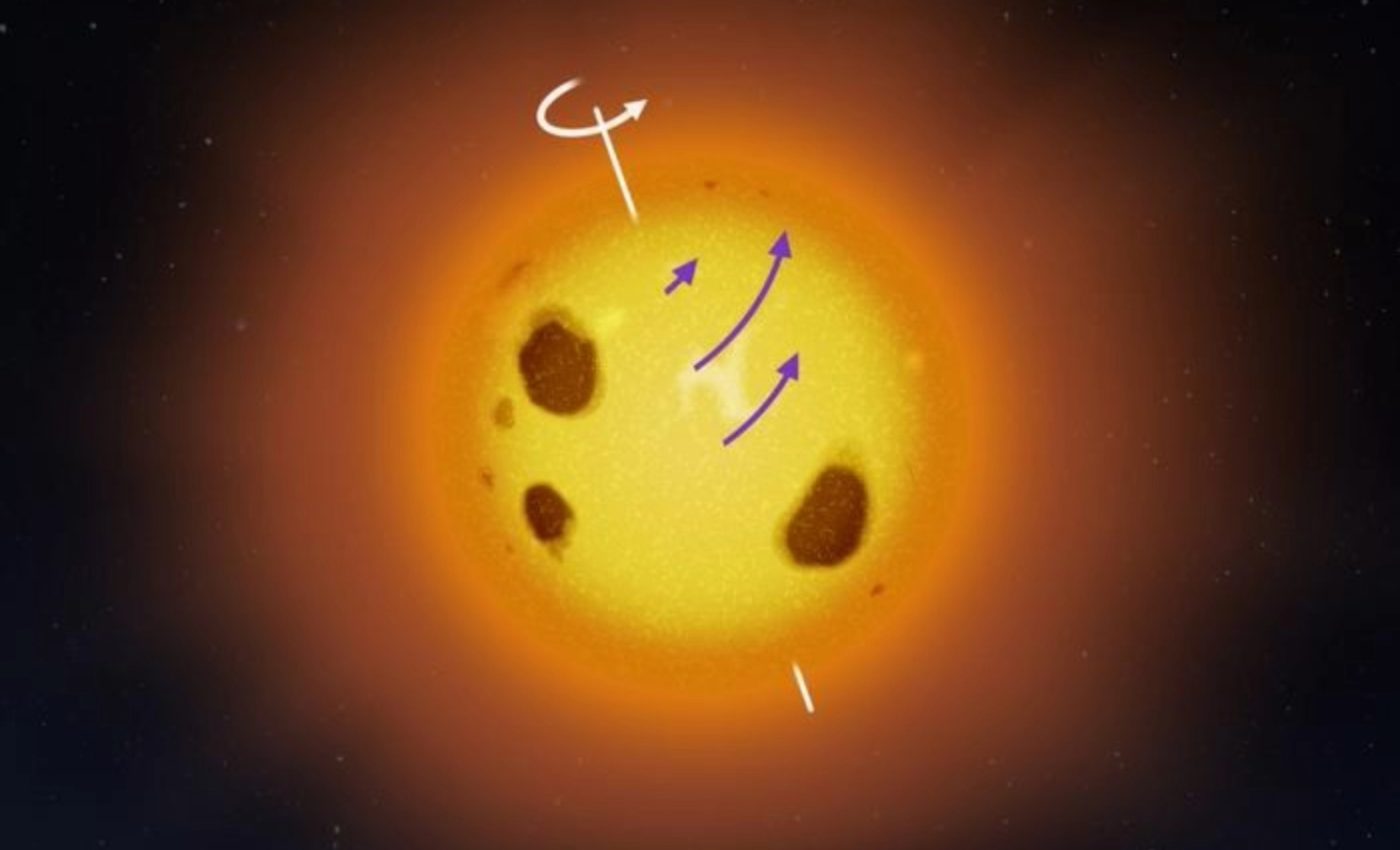
Unusual rotation of a nearby star has never been seen before
Astronomers from the University of Helsinki have recently discovered that the rotation of a nearby star, V889 Herculis, is markedly different from that of our Sun, offering new insights into fundamental stellar astrophysics.
This finding could help improve our understanding of solar activity, including the formation of sunspots and solar eruptions.
Challenging theories about star rotation
Unlike the Sun, which rotates fastest at the equator and slows down towards the poles, V889 Herculis – located about 115 light years away in the constellation of Hercules – exhibits its fastest rotation at a latitude of around 40 degrees.
Both the equator and polar regions of this star rotate more slowly. This unexpected rotational pattern has not been observed in any other star and challenges existing theories about stellar rotation, which has long been considered a well-understood physical property.
“We applied a newly developed statistical technique to data from a familiar star that has been studied at the University of Helsinki for years. We did not expect to see such anomalies in stellar rotation,” said Mikko Tuomi, who coordinated the research.
“The anomalies in the rotational profile of V889 Herculis indicate that our understanding of stellar dynamics and magnetic dynamos are insufficient.”
Understanding stellar astrophysics
V889 Herculis shares many characteristics with a young Sun, offering clues about the Sun’s history and evolution. Understanding stellar astrophysics is crucial for predicting phenomena like sunspots and solar eruptions on our own Sun.
Stars, including V889 Herculis, are spherical plasma structures composed of charged particles. Unlike planets, they lack solid surfaces and are dynamic entities, balancing the pressure from nuclear reactions in their cores against their own gravity.
Fascinating rotation patterns of stars
One of the fascinating aspects of stars is their differential rotation, meaning that the rotation rate varies depending on the latitude. This effect is caused by the movement of hot plasma to the star’s surface through a process called convection.
Convection interacts with the star’s angular momentum, leading to different rotational speeds at different latitudes – faster near the equator and slower near the poles.
However, various factors, including a star’s mass, age, chemical composition, rotation period, and magnetic field, influence these rotational dynamics, leading to variations in differential rotation profiles across different stars.
Significance of the research
Thomas Hackman, a docent of astronomy who participated in the research, highlighted the significance of this discovery.
“The Sun has been the only star for which studying the rotational profile has been possible,” said Hackman. “Stellar differential rotation is a crucial factor that affects the magnetic activity of stars. The method we have developed opens a new window into the inner workings of other stars.”
The astronomers at the University of Helsinki’s Department of Particle Physics and Astrophysics applied a new statistical modeling technique to long-term brightness observations of nearby young stars.
This method allowed them to model the periodic variations in brightness by accounting for the differences in spot movement across various latitudes. By analyzing this spot movement, they could estimate the rotational profiles of these stars.
Valuable insights from long-term data
The study also examined a second star, LQ Hydrae, located in the constellation of Hydra. Unlike V889 Herculis, LQ Hydrae was found to rotate more like a rigid body, with little variation in rotation speed from the equator to the poles, indicating very small differences in rotational speed across latitudes.
The researchers based their findings on data collected from the Fairborn Observatory, where the brightness of these stars has been monitored with robotic telescopes for about 30 years. This long-term data provides valuable insights into the behavior of the stars over extended periods.
Observing the behavior of stars
Mikko Tuomi expressed appreciation for the contributions of senior astronomer Gregory Henry from the University of Tennessee, who leads the observational campaign at Fairborn Observatory.
“For many years, Greg’s project has been extremely valuable in understanding the behavior of nearby stars. Whether the motivation is to study the rotation and properties of young, active stars or to understand the nature of stars with planets, the observations from Fairborn Observatory have been absolutely crucial,” said Tuomi.
“It is amazing that even in the era of great space-based observatories, we can obtain fundamental information on stellar astrophysics with small 40 cm ground-based telescopes.”
Rapid rotation of nearby stars
Both V889 Herculis and LQ Hydrae are approximately 50 million years old and share several characteristics with a young Sun. They rotate rapidly, with rotation periods of about one and a half days.
Due to their rapid rotation, the long-term brightness observations contain many rotational cycles, allowing for detailed study. These stars were selected as targets for this study because of the extensive observational data available and because they have been actively studied at the University of Helsinki for many years.
This unexpected discovery of a unique rotational profile in V889 Herculis not only challenges our current understanding of stellar dynamics but also opens new avenues for research into the magnetic activity and evolution of stars.
The study is published in the journal Astronomy and Astrophysics.
Image Credit: Jani Närhi, University of Helsinki
—–
Like what you read? Subscribe to our newsletter for engaging articles, exclusive content, and the latest updates.
Check us out on EarthSnap, a free app brought to you by Eric Ralls and Earth.com.
—–













